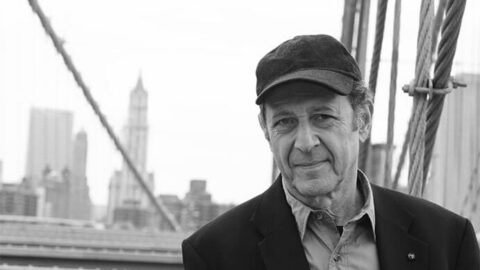Lincoln Center’s “Reich/Reverberations” festival proved Steve Reich’s musical effect can withstand poor acoustics. The July 19, 2016 concert displayed an important idea in Reich’s work through Triple Quartet (1998), WTC 9/11 (2010), and Different Trains (1988). These whirlpool pieces of energy, prerecorded pieces, and narrative weight are not easy listening; then add a room full of New Yorkers about to hear September 11th air traffic recordings and panicked violins. The programming order helped with digestion.
The concert had a novel beginning with the alternate version of Triple Quartet (1998). Instead of one live string quartet and two pre-recorded string quartets, twelve of Ensemble Signal‘s string players attached mics to their instruments and let loose a saturated, motoric sound. So many amplified players added novelty to the program but also cost Reich’s interlocking rhythms their crispness. At times they seemed like like a gypsy-rock band losing subtlety to constant volume. Some of the ensemble’s harmonic shifts were imprecise and seemed to fall behind the beat, softening the rhythmic contrast between the first movement’s propulsive energy and the second movement’s melodic squiggles. Violin canons still surfaced in the second movement as some of the evening’s most exquisite yearning, and the group rallied in the third movement to get a groove.

After the abstract energy of Three Quartets, the Manhattan audience received a concrete narrative in WTC 9/11 (2010). Reich used electronic manipulation and exact imitation by strings to augment and sustain the melody of words from or about September 11. The twelve players remained on stage, but only one string quartet put in earpieces to played with two recorded string quartets and speech. Freed from the responsibility of driving the piece, they echoed the melodic rubble without lag but were once again challenged by acoustics. Loud volume distorted the first movement’s grainy public domain recordings even more. The spoken melodies should have been the dominant element of the second movement, but amplification caught the spoken consonants and rhythm usurped sensitive echoes from the strings.
In a game of electric escalation, the amplified instruments had to contend with the recordings’ dramatic volume. This added a sense of contention to the performance that conflicted with the work’s responsive qualities. The strings thrust the piece forward in slabs of stepwise fragments, but inflexible volume diluted moments of grief or horror. Unexpected support came at the second movement’s climactic “Suddenly it was black outside… you could not see in front of you.” The house lighting faded, ensnaring the audience and entire performance space in the moment. After a beautiful hush between movements, the light returned with the recording of Jewish cantors singing traditional shmira songs, a practice to guard bodies until burial. The accompanying strings swelled over the recording and became a live cantor, blooming over the tape “And there’s the world right here.” Reich came from the audience to share several bows with the performers.

Intermission gave everyone time to reset for Different Trains (1988). Different Trains featured the best elements of the previous two pieces. Like WTC 9/11, it features weighty historical narrative with melodic material generated by prerecorded human speech. JACK Quartet brought iron spark precision missing from Triple Quartet to this final performance of their quartet’s original members. Their railroad of whistles and bells went from cheerful to eerie and back again. A constant train signal blasted from Ari Streisfeld on second violin, and Kevin McFarland on cello emerged through the texture with definite melodic girth. The second violin and John Pickford Richards on viola gave glorious train whistle intervals, and Christopher Otto’s brassy first violin kept locomotion spinning around the generating speech fragments.
JACK’s harmonic changes were brusqe but not disjointed. The cello and viola’s nimble melodic fragments were fresh atop sustained violin tones. The strings layered sirens upon whistles in the second movement as Holocaust survivors gave their memories. Tight tracking intervals expanded into three-part siren chords, crescendoing into horror before breaking into a smoking silence. The house lighting once again dimmed before returning with the hopeful third movement. Bell sounds replaced sirens, the second violin and viola glittered in unison, and the ending floated off the ground in a shimmering concert finish.
Acoustic challenges diluted the concert’s emotional effect, but the valiant efforts of Ensemble Signal and JACK Quartet refined the evening into a fair celebration of Reich’s work. Many bows at intermission and a standing ovation at the end of the concert proved that his musical experimentation and terse, emotive syntax were the evening’s ultimate highlight.
























